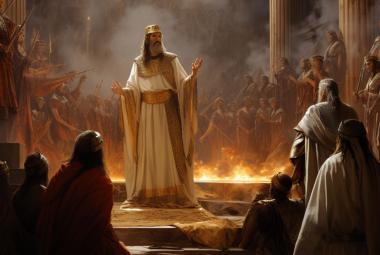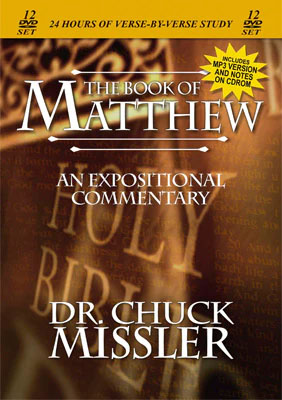The first thing to notice about the Gospels is that they are skillfully designed; each one is tailored to suit its specific perspective. Matthew was a Jew, a Levite; he presents Jesus Christ as the Messiah of Israel-the Lion of the Tribe of Judah. This first book of the New Testament plunges right in to establish Jesus as the Meshiach Nagid, the Messiah the King.
After first establishing the royal genealogy, Matthew then proceeds to focus on the fulfillment of the Old Testament prophecies: Matthew uses the term fulfilled 82 times! (Again, his interest was to present Jesus as the Messiah of Israel; Jesus credentials are that He fulfilled prophecy.)
The first miracle described in Matthew is also very Jewish-the leper was cleansed, and leprosy was, to Jews, a sign of sin. Matthew also ended his Gospel in a very Jewish way; with the Resurrection. [Matthew left out the Ascension, but remember that it is not a milestone in respect to Jesus Messianic mission (His return, however, will be).]
Stenographic Skill
Matthew emphasized what Jesus said. He evidently recorded the discourses verbatim. As a customs official, he was a tachygrapher, or shorthand writer.1 (The reason Matthews Gospel is so much longer than Marks is that he includes Jesus extensive discourses, such as the Sermon on the Mount and the Olivet Discourse; without these discourses, Marks Gospel is longer!)
Early Origin
Many scholars now believe that the Gospels were written before Paul's first imprisonment in 57-60 A.D., and that virtually all of the New Testament books were written before Jerusalem's destruction.2
There is no hint in the New Testament of Nero's persecutions after 64 A.D., nor of the execution of James, the Lords brother, in 62 A.D. There is not the slightest mention of the Jewish revolt against the Romans, which began in 66 A.D., nor of the destruction of Jerusalem in 70 A.D. These historic events would have been irresistible in making many of the arguments in the New Testament documents.
 Textual evidence suggests that the Gospels were originally written in Hebrew. In hundreds of places the Greek sentence structure betrays a Semitic influence and implies a translation from the Hebrew. It appears that within five years after the death and resurrection of Christ, most of His words and deeds had been committed to a simple written Hebrew form and Matthew is, of course, assumed to be part of this compilation.
Textual evidence suggests that the Gospels were originally written in Hebrew. In hundreds of places the Greek sentence structure betrays a Semitic influence and implies a translation from the Hebrew. It appears that within five years after the death and resurrection of Christ, most of His words and deeds had been committed to a simple written Hebrew form and Matthew is, of course, assumed to be part of this compilation.
Within a decade, this corpus would have been translated into a Greek version for church requirements. This corpus, or its variations, is often called the Q-document (for German, quelle, source).
Around the year 50 A.D. the original material was developed into written Greek form and the synoptic Gospels were composed, probably since the persecutions were imminent. The key point is that eyewitnesses were still around to verify the details.3 A summary diagram is shown, see left.4
Papyrus Discovery
In 1994, an ancient segment of the Greek text of Matthews Gospel was analyzed and it appears to be dated before 66 A.D. Known as the Magdalen Papyrus, P64, it contains segments of Matthew 26:23 and 26:31 on both sides of three fragments. Using a scanning laser microscope, it has provided physical evidence that the Gospel according to Matthew is an eyewitness account written by contemporaries of Christ.5
Structural Discoveries
It was through the amazing efforts of Dr. Ivan Panin (1855-1942) that the heptadic (seven-fold) structure of the Biblical text was revealed. Of the many remarkable discoveries, perhaps the most provocative is that the vocabulary that is unique to Matthews Gospel (i.e., words that are not used elsewhere in the New Testament) is an exact multiple of 7.6
How could this feature have been deliberately organized? Only by one of two ways: either all of the other writers of the New Testament
had to agree, in advance, not to use these particular words (which is highly unlikely!); or, Matthew would have had to compose his Gospel last. Think about it: this is a strange property to engineer into the text.
Employing the argument that this proves that Matthews Gospel was, thus, the last to be composed is a bit treacherous, however, since the same feature is true of the Gospel of Mark: the vocabulary which is unique to Marks is also an exact multiple of 7. And so is Luke's. And Johns. And also the writings of Paul, James, Peter, and Jude! Each, thus, appears to have been written last. This strange design feature seems clearly to be a fingerprint of the supernatural Author Himself.
Provocative Hermeneutics
One of the most fundamental principles of Biblical hermeneutics-principles of interpretation-is the emphasis on the context. And, indeed, that is of crucial importance in applying any Biblical passage.
However, Matthew seems to take some very provocative excursions that are instructive.
In Matthew 2:15, he applies Hosea 11:1, Out of Egypt I have called my son, to the flight of Joseph, Mary, and the child to Egypt to escape from Herod's infanticide. An examination of the context of Hosea 11 makes such a Messianic application seem a far reach, indeed! Only by the Holy Spirit could Matthew have justified this linkage.
(A similar stretch appears in Matthew 2:17-18, where he ostensibly applies Jeremiah 31:15 to this same tragic infanticide.)
Your Challenge
Matthews thoroughness and precision lends many special insights as one delves into his detailed presentations.
His rendering of the Seven Kingdom Parables in Chapter 13 is remarkably parallel to the Letters to the Seven Churches in Revelation Chapters 2 and 3, etc.
His presentation of Jesus confidential briefing to His disciples about His Second Coming in Chapter 24 is an essential foundation in any eschatological (end-time) study. So, clearly, this very basic book of the Bible is, of course, a most rewarding study to both novice and experienced Bible students who are willing to diligently dig in.
Our prayers are that you will be blessed as you embark on this fascinating study!
Passages Unique to Matthew Comparing synoptic gospels, there are some Four events connected with His infancy: 1) Visit of the wise men (2:1-15); Ten Parables: 1) The Tares (13:24-30); Two Miracles: 1) The Two Blind Men (20:30-34) Nine Special Discourses: 1) The Sermon on the Mount (5-7); Six Events in Connection with His Passion: 1) Conspiracy and Suicide of Judas (26:14-16, 27:3-11); [E.W. Bullinger is credited for this list.] |
Notes:
- Even in the Old Testament, in Psalm 45:1, the Hebrew,
mahiyr caphar , the ready writer (KJV), or skillful writer (NIV), is translated in the Greek Septuagint, oxygrphos, a synonym for tachygrphos, or shorthand writer. (The technical term must have been common enough among Greek-speaking Jews in the 3rd century B.C. for its use in the Septuagint to have any purpose.) - Risto Santala, The Messiah in the New Testament, p.47-48.
- Mark appears to quote Luke; in over 150 places in Mark appears to know Acts; some infer that he also knew of the letters to the Thessalonians, Corinthians, Romans, Colossians, and James.
- This view is sometimes referred to as the Jerusalem School after David Flussey and Robert Lindsey of the Hebrew University.
- Dec 24,1994, The Times, London, front page. Carsten Peter Thiede, Director of the Institute for Basic Epistemological Research in Paderborn, Germany; first published in Zeitschrift fr Papyrologie.
- There are 42 unique words (7 x 6) which have 126 letters (7 x 18).







